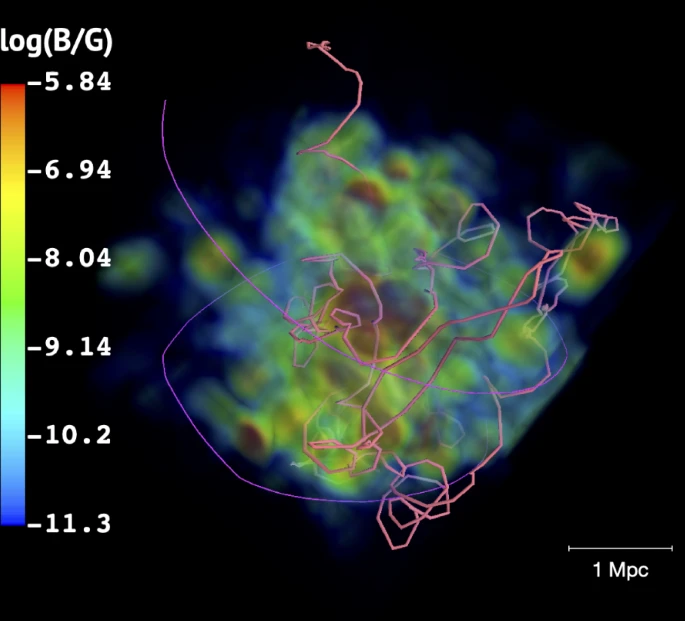Centro de Excelencia Severo Ochoa
Menu
Search

• The most detailed computational simulations to date have revealed for the first time that galaxy clusters could be a significant source of unknown gamma radiation.
• The scientific paper describing this research was published in the journal Nature Communications and featured the crucial contribution of Rafael Alves Batista, a researcher at the Institute for Theoretical Physics (IFT) UAM/CSIC, who developed the fundamental code used in the study.
High-energy gamma-ray radiation, particularly above 1 GeV to 1 TeV, has been a phenomenon studied in the field of astrophysics for years. There is a diffuse distribution of high-energy gamma rays observed coming from all directions in the sky. While many sources that can generate this radiation are known, there is still an unknown component with unidentified sources. One possible explanation for this unknown radiation could be dark matter, whose nature is not yet fully understood. However, it is unknown what other sources could contribute to this emission.
This is where clusters of galaxies come into play. These clusters are a key object of study to understand their contribution to high-energy gamma-ray emission. Clusters of galaxies are structures that contain hundreds of individual galaxies and are gravitationally bound.
These structures also contain gas, and particle acceleration processes occur within them. Cosmic rays are accelerated both by astronomical objects present in the clusters and by the intracluster medium itself. The interactions of these cosmic rays could be responsible for a significant portion of the production of gamma rays, neutrinos, and other particles.
The paper describing this research was published in the journal Nature Communications and involved the participation of IFT researcher Rafael Alves Batista, one of the main authors of the study, who contributed to the conception of the work, simulations, and data analysis. Other authors include Saqib Hussain, now a postdoctoral researcher, and at the time a doctoral student. Elisabete M. de Gouveia Dal Pino supervised Hussain's doctoral work and coordinated the study. Klaus Dolag performed the cosmological simulation.

As previously mentioned, this simulation is one of the largest and most detailed available, spanning from the early galaxies about ten billion years ago to the formation of current structures. Properties obtained from these simulations, such as gas distribution, magnetic fields, and radiation, were used to study the propagation of cosmic rays and their interaction with the gas present in the clusters.
Alves Batista, one of the main authors of the article, also contributed a key tool in developing the simulation. It is a particle propagation code known as CRPropa. This code allows the calculation not only of the probability of interaction of particles such as protons with the background present in the clusters of galaxies but also the trajectories of these particles. Additionally, the code calculates the properties of the particles produced in these interactions, including the formation of pions and the subsequent generation of gamma rays. Alves Batista and other colleagues started developing CRPropa years ago, and this tool has multiple uses in astroparticle transport theories in astrophysical environments and at cosmological distances.
The computational simulation conducted in the recent study covers a large region of the universe, with a size of about 9,000 megaparsecs, roughly 30 billion light-years, while the region simulated in detail is approximately 200 megaparsecs. According to Alves Batista: "The simulated sample is quite representative, and in fact, it is expected that the rest of the universe has similar characteristics."
The research concludes that clusters of galaxies can be a significant source of high-energy gamma-ray emission. If this is true, there could be a substantial contribution from clusters in the observed flux from Earth, limiting the contribution of other astrophysical objects.
However, it is worth noting that these results are theoretical and have not yet been experimentally confirmed. In the future, it is expected that telescope data will confirm these approximations. For example, existing telescopes such as Fermi-LAT and future ones like the Cherenkov Telescope Array (CTA), in which the IFT is involved.
In summary, these results contribute to improving the understanding of the diffuse flux of gamma rays, which is still not fully understood.
A Project funded by la Caixa” Foundation (ID 100010434) and European Union’s Horizon 2020 research and innovation program under the Marie Skłodowska-Curie grant agreement No 847648 (fellowship LCF/BQ/PI21/11830030)
Hussain, S., Alves Batista, R., de Gouveia Dal Pino, E.M. et al. The diffuse gamma-ray flux from clusters of galaxies. Nat Commun 14, 2486 (2023). https://doi.org/10.1038/s41467-023-38226-w
Social media